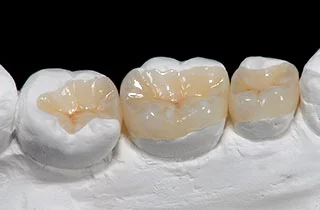The well-known way to treat tooth decay is a dental filling, however, itis not always a possible option, as its successful application has its limitations. In this case, there is no need for despair and thinking of crown or prosthesis. Dental inlay and onlay often prove to be the perfect solution for treating more extensive tooth injuries.
This article will answer the following questions about a dental inlay:

- What is a dental inlay?
- Inlay-or-onlay?
- When is a dental inlay the best choice?
- How are dental inserts made?
- Which materials are used for dental inlays?
- How much do dental inlays cost?
What is a dental inlay?
A dental inlay is a type of dental filling that either complements or fills damaged parts of the teeth. When the removed parts are so big due to tooth decay or damage that the dental filling is no longer suitable for its proper filling, tooth inserts are possible solutions. The difference between dental inlays and other types of dental fillings is that dental inlays are manufactured for and adjusted to the individual tooth. A dental inlay is used for minor injuries where it is not necessary to cover the entire chewing surface.
Inlay-or-onlay?
A dental onlay is used for larger holes where the entire chewing surface needs to be covered or the injury extends through multiple teeth. In this case, besides the insert protects and covers the tip of the tooth it also protects the inside of the tooth and the chewing surface.
Dental onlay forms a transition between a dental inlay and the crown. Its advantage is that there is usually no need to remove parts from the dentin during the preparation.
When is a dental inlay the best choice?
Dental inlays are the solution when the tooth isn’t so damaged to require a dental implant. Also, the application of a dental inlay improves the aesthetics of the teeth because it covers up even the smallest defects.
Dental implants have several benefits. One such advantage is that in case of proper preparation, they are securely attached to the tooth. Moreover, due to the tight bond, the insert protects the healthy parts of the tooth from further damage.
Inlay inserts provide a very similar appearance to a healthy tooth: the insert is perfectly able to mimic the look and aesthetics of the previous tooth in both colour and shape.
How are dental inserts made?
At least two visits are required to make and fix dentures.
At the first appointment, carious tooth parts and previous fillings will be removed. The specialist then takes a precision sample from the cavity and seals the tooth with a temporary filling. After sampling, the dental insert is made in a dental laboratory.
At the second appointment, the temporary filling is removed, and then the dentist glues the finished dental insert and illuminates it with a special lamp. At the end of the treatment, the glued surface is fine-tuned and polished.
Which materials are used for dental inlays?
Dental inlays are made of several materials: ceramics, gold, galvanic, titanium and synthetic materials .
Different materials
- Evidently if aesthetics is the main requirement, a ceramics dental inlay is the most appropriate solution. Experience shows that most patients prefer ceramic dental inlays.
- Usually, all dental inlays are very long-lasting. However, gold dental inlays are the most durable. These are made of high-grade steel, so they have the highest costs. Evidently, in more visible tooth areas gold dental inlays are not favourable because of the difference in colour. In such tooth areas patients prefer ceramics dental inlays, since these are less
noticeable. - Another type is the galvanic dental inlay, which is a combination of gold and ceramics.
- Nowadays dental inlays made of titanium or a certain synthetic materials are manufactured and applied more and more often. These are made of high-graded plastics and are also called composite inlays.
How much do dental inlays cost?
Using a dental inlay you can prevent or avoid the application of a crown or even of a dental implant. Dental inlays are also more cost-efficient since their costs are lower than the costs of a crown or of a dental implant. The dental inlay costs depend on the materials in use, on the costs of the dentist, and those of the dental laboratory.
Usually with dental treatments in Hungary, one can save more money. For example ceramics dental inlays cost approximately 360 £ per unit.


